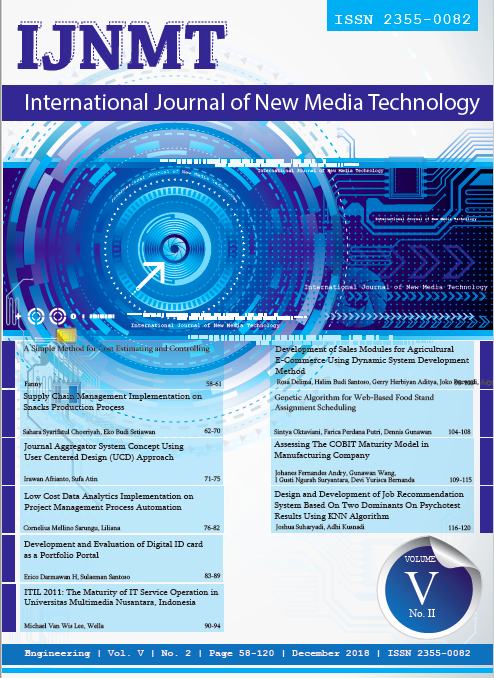The Journal Aggregator System Concept Using User Centered Design (UCD) Approach
DOI:
https://doi.org/10.31937/ijnmt.v5i2.844Abstract
Journal as a medium to explain the results of research. It has developed in such a way especially because of the rapid support of information and communication technology today. Various models of online-based journaling management can be easily operated by journals managers as well as writers / researchers who will include research results in the journal. It's just that with the number of journals that exist today, causing difficulties for the manager of journals to be able to promote the journals he managed, in addition to the manager of the journal sometimes difficult to get a researcher who would put his paper into the journal he manages. Meanwhile, with the number of journals that have been online, researchers will find it difficult to get information from the journals. Researchers should open their journal entries, read their profiles and publications, until they are interested to include papers in the journal. This problem is the background of the development of online journals aggregator system, which with this system will facilitate the meeting between journals, journal managers and writers or researchers. In order to develop an online journal aggregator system, a software development method is needed that directly captures the needs of its users. User Centered Design (UCD) is a philosophy in software design that puts users as the center of system development. The UCD approach has been supported by various techniques, methods, tools, procedures, and processes that help design a more user-centered interactive system. With UCD it is expected that the online journals aggregator system can produce a design that will make it easier for its users, both in terms of functionality and from the side of the system interface.
Downloads
Downloads
Published
How to Cite
Issue
Section
License
Authors retain copyright and grant the journal right of first publication with the work simultaneously licensed under a Creative Commons Attribution-ShareAlike International License (CC-BY-SA 4.0) that allows others to share the work with an acknowledgement of the work's authorship and initial publication in this journal.
Authors are able to enter into separate, additional contractual arrangements for the non-exclusive distribution of the journal's published version of the work (e.g., post it to an institutional repository or publish it in a book), with an acknowledgement of its initial publication in this journal.
Copyright without Restrictions
The journal allows the author(s) to hold the copyright without restrictions and will retain publishing rights without restrictions.
The submitted papers are assumed to contain no proprietary material unprotected by patent or patent application; responsibility for technical content and for protection of proprietary material rests solely with the author(s) and their organizations and is not the responsibility of the IJNMT or its Editorial Staff. The main (first/corresponding) author is responsible for ensuring that the article has been seen and approved by all the other authors. It is the responsibility of the author to obtain all necessary copyright release permissions for the use of any copyrighted materials in the manuscript prior to the submission.















